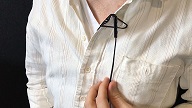Audio and sound in video
Good sound in a video is really important. Clear sound is especially important in video sessions where the viewers cannot see the speaker's lip movements, for example in narrated PowerPoint presentations. Focus on good sound quality and a good microphone, such as a headset or a handsfree (for mobile phone).
Sound quality more important than video quality
In a video, a viewer can ignore or even miss poor picture quality, but if you lower the sound quality, it is almost impossible to ignore. The sound is also the basis for automatic subtitling, so good sound quality and clear speech at the time of recording increases the probability of a more accurate automatic subtitling.
Tips for better sound quality
Since sound quality is so important, we have collected some tips on improving sound quality:
- Test listen to the sound from the microphone you are going to use before you start recording.
- Record in a quiet room and turn off all annoying sound sources, such as your mobile phone.
- Avoid rooms with bare walls as they echo. You can hang fabric on walls to dampen echoes.
- Leave short pauses of total silence between sentences or paragraphs to give you the opportunity to cut into the sound unnoticed, for example during retakes.
- Do not be afraid to repeat sentences during the recording, just remember to cut out the incorrect ones.
Tips of how to use the microphone
Which microphone you use when recording is very important for the sound quality, but also how you use the microphone matters.

- Use a microphone that can be placed close to your mouth, like a headset (headphones with microphone) or a handsfree (for mobile phone). Start by testing the distance between your mouth and the microphone, consider the following tips:
- Too big distance from the audio source makes the recorded sound weaker, and the microphone also picks up surrounding noise and sound disturbances.
- If you place the microphone too close to your mouth, you may experience a rattle noise.
- If you need a longer distance to the computer when recording your lecture, you can use an extension cord for your handsfree or headset.

- Clamp your handsfree on a jacket or shirt stroke, or alternatively in the jersey neck collar, for example with a microphone clip (so-called clip) or a regular clip. Test listening before you start recording so that the microphone does not rustle on your clothes as you move because it produces disturbing sound.
- Since the sound is so important for the video quality, the tip is to record in a quiet room and turn off all the interfering sound sources, such as the mobile phone.
- Good sound quality makes it easier when it's time to add captions to the video.
